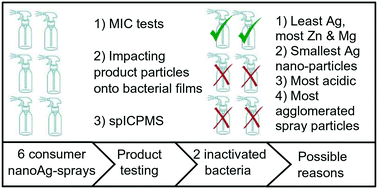Inactivation of pure bacterial biofilms by impaction of aerosolized consumer products containing nanoparticulate metals†
Abstract
The ability of nanotechnology-enabled consumer sprays to inactivate bacteria has direct health implications. This research investigated the ability of six nanosilver-based consumer sprays to inactivate bacteria. We determined the minimal inhibitory concentrations (MICs) of the products by an agar dilution method, collected particles released from sprays onto bacterial films using impactors, and determined metal concentrations in the products using ICPMS. Also, the size of silver nanoparticles in the products' suspensions was determined using single particle (sp)ICPMS. Two of the six nanoproducts inhibited growth of Escherichia coli and Bacillus atrophaeus bacteria (MICs of 40 000 and 160 000 ppm). Collection of particles aerosolized from these two products onto films of the same bacteria inhibited bacterial growth; however, the mass concentration deposited onto bacterial films was lower than the MICs. Furthermore, these two nanoproducts had the lowest silver concentrations compared to the other four nanosilver products. Yet, they had the smallest nanosilver particles: mean size of ∼20 to 30 nm vs. ∼45 nm for the other products. Their suspensions were more acidic (pH ∼3–5) and had higher concentrations of zinc and magnesium compared to other products. This research illustrates that some consumer nanoproducts have antibacterial potential and may affect our microbiota. Yet, the inactivation potential cannot solely be presumed based on the nanosilver presence and concentration in the product; the final nanoproduct's form, including its matrix, must be considered. As nanomaterials are increasingly incorporated into consumer goods, this research highlights the need to investigate final-form consumer nanoproducts and their potential to affect our microbial environment.



 Please wait while we load your content...
Please wait while we load your content...